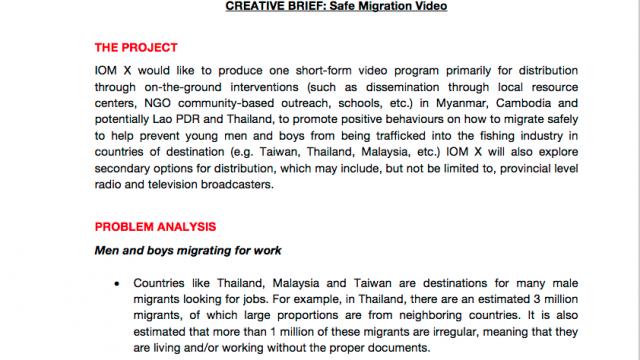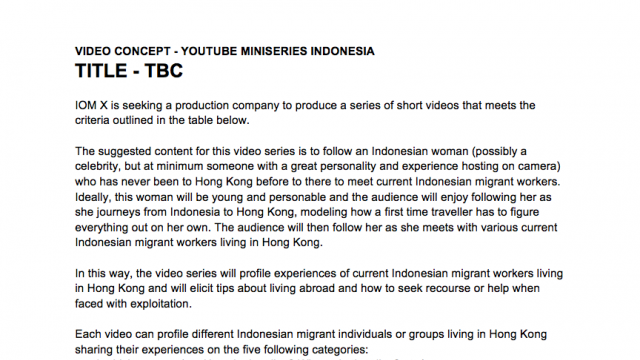During the STRATEGIC DESIGN phase, the following are planned and developed:
1. SMART objectives
2. Communication channel analysis
3. Communication strategy
4. Creative brief
5. Monitoring and evaluation plans
1. SETTING SMART ACTIVITY OBJECTIVES
An objective refers to a set of activity goals or targets, such as the desired changes in the problem situation, behaviours or knowledge. Turning your objectives into SMART objectives ensures they meet the necessary requirements to be able to measure the intended progress or change.

Examples of SMART objectives:
- After viewing this programme about domestic worker rights, 30 per cent of surveyed viewers who employ live-in domestic workers in their home will be able to recall three rights to which domestic workers are entitled.
- After watching this animation on safe migration, 10 per cent of surveyed aspirant migrant Cambodian and Myanmar men and boys (aged 15 to 30) from rural areas can recall the counter-trafficking hotline number in Thailand.
- After training on improved interpersonal communication skills, 80 per cent of trained psycho-social support counsellors show demonstrated improvement in their counselling skills and confidence to counsel (as per set criteria on body language, tone of voice and key messages).
TIP: What is awareness?
If your objective is about ‘raising awareness’ it is important to define what ‘awareness’ means in the context of your intervention. This term, like others such as ‘understanding’ are vague and can lead to misunderstandings. It is, therefore, important to define objectives as precisely as possible, and consider clearer alternatives to using such words.
In labour migration campaigns, for example, a clear definition of ‘awareness’ could be: ability to recall the rights entitled to workers in a specific sector, ability to recall a hotline number to report suspected exploitation, etc.
2. COMMUNICATION CHANNEL ANALYSIS & DISSEMINATION STRATEGIES
Now it is time to start designing the activity and determining how messaging will be disseminated. The table below outlines communication channels by their reach, suitable message type, cost and how it can be used to facilitate two-way dialogue. Each channel is also described as ‘mass media’ or ‘community media’. Community media is usually well suited for a narrow target audience, whereas mass media is suited for large-scale audiences. It is best to select the channels that match the target audience’s media consumption preferences to ensure effectiveness.
Table 5: Communication Channel Characteristics
| Channel type (mass media vs. community media?) |
Reach | Type of message (simple/complex) |
Cost | Is it interactive? |
|---|---|---|---|---|
| Television (mass media) |
Can reach large If power outages are |
More general messages often used as television reaches a broad scope of targets. General information, news or entertainment. Public service announcements can be used for short simple messages. Dramas and soap operas better for complex messages. Engaging and influential. |
Production and airtime costs can be very high. Buying TVs for |
Community-based shows, live call-in shows, debates/ discussion between a cross sector of the audience are some of the possibilities. |
| Radio (mass media or community media) |
Large reach, both Can reach illiterate |
As above, general information/news or entertainment ideal for radio. Radio dramas convey complex messages. |
Lower prices for radios. Listeners' club can lower costs. Lower production costs than TV. |
Call-in shows, answering listener questions on air and community outreach shows. |
| Film (mass media or community media) |
Depends upon the popularity of cinemas and availability of film facilities (e.g. cinema halls, community screenings). |
Films are good for complex messages due to time available to work through messages with audience. |
Production very costly with long production time. |
Discussions and question and answer sessions following screening can be interactive. |
| Online video (mass media) |
Reach can be large for online audiences. | Can be made for general or specialized audiences. Complex messages and scenarios can be depicted. |
Dependent on the quality of production desired. | Generate immediate discussion in online forums. |
| Newspaper/ magazine (mass media or community media) |
Large reach for literate audiences. Depends on circulation levels. |
Specific announcements, technical information, short clear messages. | Reasonably priced. Advertisements are expensive, but news can be printed for free. |
May stimulate local discussions. |
| Posters/billboards (mass media) |
Can have a wide reach depending on effective placement. | Suitable for short and focused messages. Do not convey complex messages effectively. |
Reasonably priced. Design and distribution may be costly. | May stimulate discussions among viewers. |
| Interpersonal communication (community media) |
Can reach small groups or individuals. | Good for specific, complex, intimate information exchange. Engaging and influential. Good for motivating specific behavioural practices. Encourages listening skills, ability to empathize and be supportive. |
Cost factors include training, equipment, transportation, etc. | Highly interactive as it allows sharing of information, responding to questions and doubts, convincing or motivating the listener to adopt certain behaviours or use certain services. |
| Community outreach, local theatre and concerts (community media) |
Small to medium sized groups, depending on the scale of the event. |
Localised messages, emotive, interactive and effective. |
Low to medium cost, although staffing, transport and props all need to be considered. |
Highly interactive. Community discussions. |
| Social media (mass media) |
Can reach young people with targeted messages. It lends itself to using multiple kinds of content: video, photos, etc. |
Simple, easily understood messages. Can also be used for simple or complex messages for targeted audience. |
Cost for dedicated staff to run and maintain social media. High cost of computers and smartphones of target audience. | Very interactive (Twitter, town hall, live Facebook chats, Google hangouts, interactive surveys, etc.) |
| Mobile applications (mass media) |
Can reach young people with targeted messages. |
Suitable for specific and focused messages. |
Cost for dedicated staff to run and maintain app. Cost of smartphones for intended audience to be considered. |
Very interactive. |
TIP: Lowering the cost
When your budget for dissemination is limited, consider which community radio/TV channels, local organizations or youth networks you could work with to disseminate messages to the target audiences. You are more likely to secure distribution partners for little to no cost when you make high quality programming and engage with potential partners for joint development (where feasible) and distribution early in the production process.
3. DESIGNING THE COMMUNICATION STRATEGY
When planning the communication strategy, identify where the audience sits along the behaviour change journey (image below). Against available data, ask questions such as:
Are they totally unaware or do they have some knowledge about the desired behaviour? Do they know the risks and benefits of their behaviour(s)? How long have they been practicing it? Are they motivated to sustain the change? Do they encourage other people to adopt the behaviour?
As shown below, there are six steps in behaviour change:
- Unaware
- Knowledge
- Deciding to act
- Action
- Maintenance
- Becomes an advocate

TIP
It is important to have ongoing monitoring activities to assess where the target audience sits along the behaviour change journey to keep designing relevant messages and activities. Monitoring will also help to identify if the target audience is moving down instead of up the behaviour change ladder, which signals that messages and activities need to be adjusted.
To move the target audience along the journey, suggested communication actions are provided to the right of each level of behaviour (as well as examples of what these communication actions look like in practice).
4. DEVELOP A CREATIVE BRIEF
By now, a lot of research has been done and it is time to turn that research into accessible information.
In order to get the creative team (whether they are internal or external) on the same page, it is important to develop a creative brief, a compilation of information that sets out the target audiences, communication objectives, key messages and content, call(s) to action, guidelines, message tone, genre and other creative considerations (as outlined in the table below). A creative brief intends to be informative, attractive, relevant, involving and persuasive.
| Creative Brief Component | Contents (questions to answer) |
|---|---|
| Audience |
|
| Changes, barriers, opportunities and communication objectives |
|
| Message brief |
|
| Key content and tone |
|
|
|
ENGAGE YOUR AUDIENCE
In Step 2: Strategic design, it is preferable to work with stakeholders and representatives of your target audience. One idea is to hold a strategic design workshop where a mix of stakeholders and target audience representatives are invited to give input. Ensure fair representation of women, men, youth and marginalized groups.
Have you:
- Identified SMART objectives?
- Selected communication channel(s) to disseminate activities and messages that best fit the targeted audiences?
- Identified where the different audience groups or segments sit along the behaviour change journey and how the activities will move them along the journey?
- Developed a creative brief?



